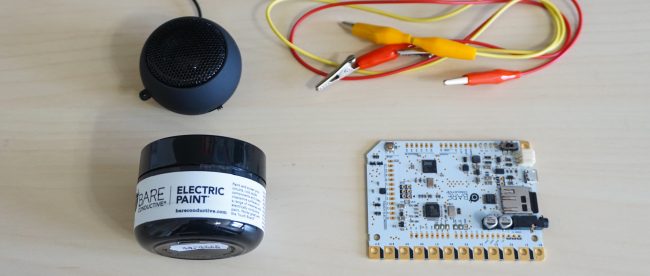Wouldn’t it be great if objects around us could just describe themselves instead of us having to figure out where and what they are? How convenient would it be for a blind person to touch or grab an object, and immediately get a description of what that object is – from the object itself?
I have started working with
Bare Conductive’s Touch Board – an Arduino based prototyping tool that can interact with objects via touch. It can be connected to practically anything through Alligator Clips or Electric Paint (for non metallic objects) and allows interaction with them when they are touched. In the video below, for example, I am using a can of chick peas (metallic object) and a photo frame (non metallic object). Touching or holding both of them gets me an audio description from the speaker connected to the Touch Board.
If you don’t want to watch the video above, these simple instructions should give you an idea of how to set it all up.
The set up is extremely simple. You will need the following for this project:
1. Bare Conductive Touch Board.
2. Micro SD Card for recording audio clips.
5. Speaker for audio output.

The Touch Board has 12 electrodes (row of holes on one side) which allow up to 12 objects to be connected. Each electrode gets its own audio description/file, so that when the object connected to the electrode is touched, the file associated with it is played (as description of the object).
You would want to record audio descriptions of the objects that you want to connect first. Once done, transfer those files to the Micro SD card, and insert the Micro SD card into its slot on the Touch Board.
Note: You have to follow a very specific naming convention. For example, audio file meant for the first electrode E0 must be titled “TRACK000.mp3”, E1 – “TRACK001.mp3”, and so on. If this convention is not followed, the files won’t play.
Start connecting your objects to the Touch Board’s electrodes. For metallic ones, you can use Alligator Clips. For non metallic ones, a little dash of electric paint on their surface will make them conductive, after which you can use Alligator Clips to connect them to the Touch Board or use electric paint all the way!
Plug in the speaker into the audio jack.
Power the Touch Board with a USB cable.
That’s it! You are up and running! On touching the connected objects, you will hear audio descriptions from the connected speaker.
This set up can be used anywhere, and with any object. Whether it’s someone’s house, kitchen, office, a museum – the list can go on and on. Just touching objects would not only enable a blind person to get familiar with their surrounding, but also help them understand what each object does/depicts. A simple example is these four photos on canvas below. For a blind person, there is no way to know what these photos are of, unless a person accompanying them describes these photos to them.
But if we use Touch Board, and connect these canvases with electric paint, a blind person would just be able to touch them and get a sense of what’s printed on them without having to depend on someone else.
Similarly, if you have a blind person coming in to your office for the first time, you can set up an “audio map” in a similar fashion on the wall where touching objects will tell them where conference room A, the cafeteria, or the bathroom is.
Check out Bare Conductive’s website for more information and projects!
Related






Leave a comment